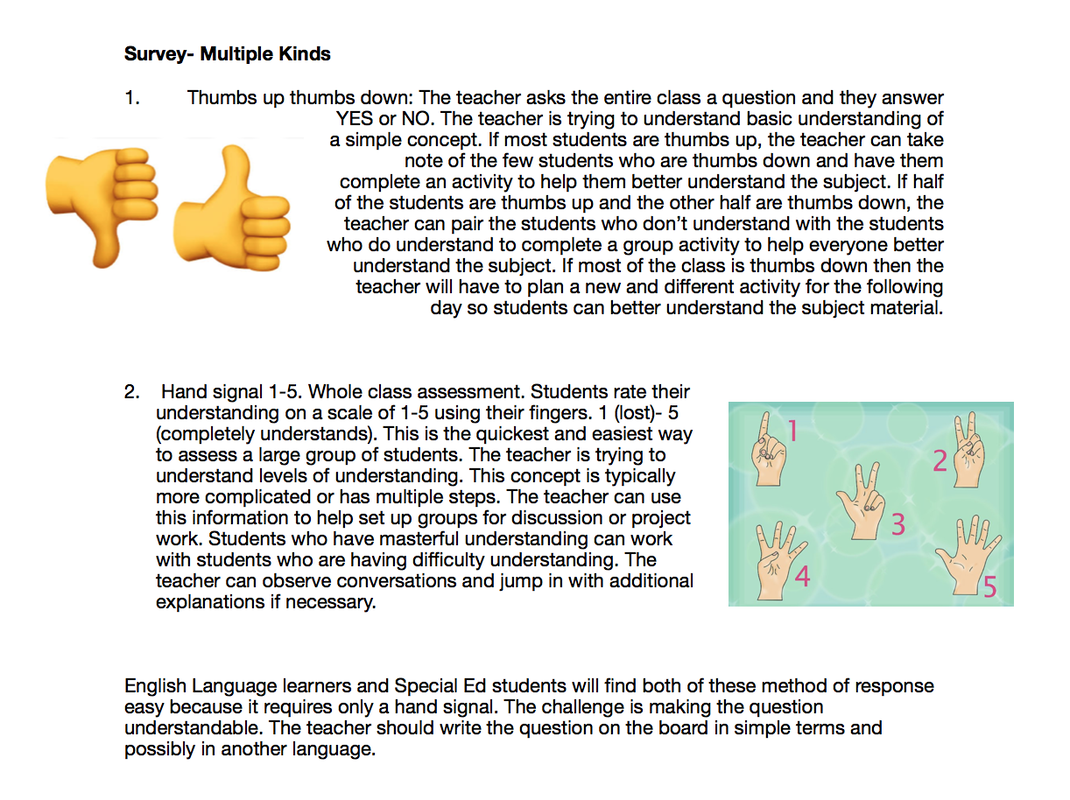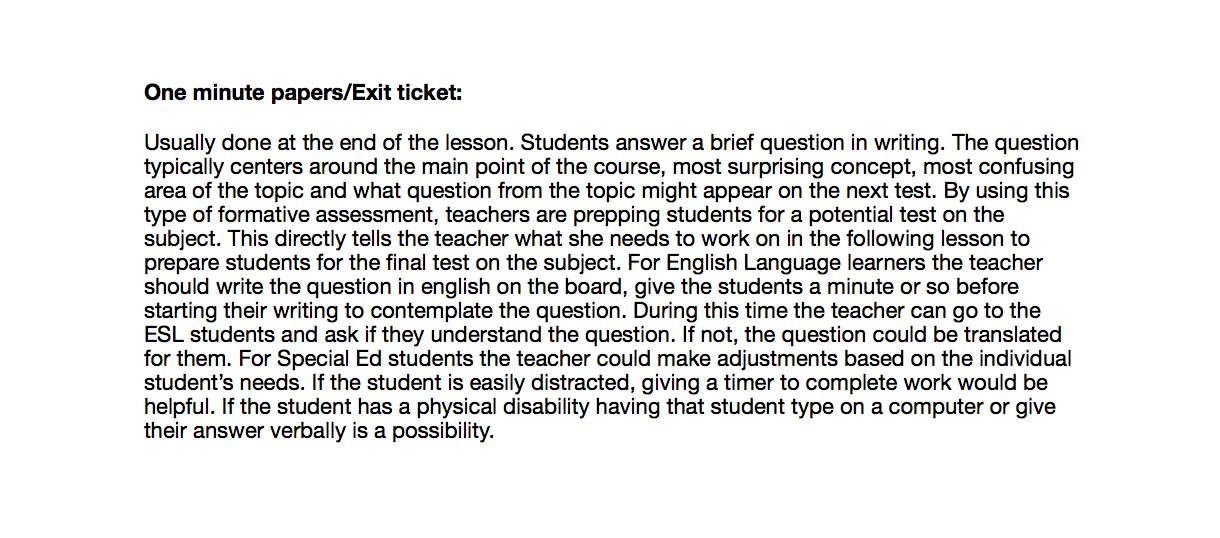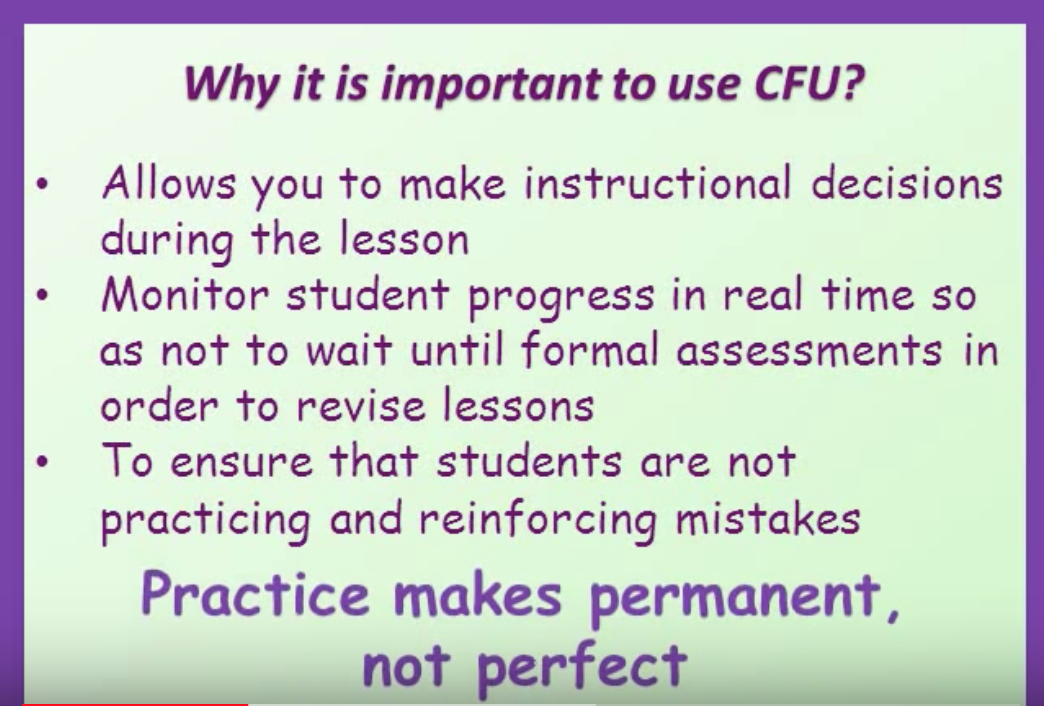|
Formative Assessments monitor student’s learning to provide ongoing feedback that can be used by instructors to improve their teaching and by students to improve their learning. The above video is an example of an exit ticket formative assessment. This is an assessment that I can use for an elementary english classroom. With the multiple choice options I gain basic information about student understanding. If I wanted to get more detailed information, I would want to host a discussion with more specific questions about the story of the three bears. I might also want to test understanding of definitions by providing multiple choice options of definitions and having students select one. A quick test for general understanding will give me limited information, but if I trust that students are answering honestly I can still utilize the data to adjust my lesson for the following day. For example, if everyone responds that they understand, I can move on to other vocabulary words or even give a summative assessment the following day. If students are responding that they do not understand or do not remember then the following day I would continue with the same subject. I could create an exercise that allows students to act out the story of the three bears. I could have the class play a vocabulary game to better understand key words. Check out my blog post on game based learning to see an example activity for learning vocab! (click below) Why should you use formative assessment? Formative assessment helps the teacher guide instruction so she don’t waste time going down the wrong path. The teacher can find out if a student needs to be re-taught a concept or if they can move on to the next topic. Formative assessment allows personalized teaching by meeting the student where they are at in the learning process. It also creates a clear picture of where the student needs to go. (SmartAtMath, 2011). Ways to determine if the formative assessment worked in the classroom: Once the teacher gathers the data from the formative assessment, she needs to then decide if the data shows an accurate reflection of classroom understanding. This determination can be completed by compiling the data in groups. One group could be "This data shows basic understanding". Another group could be "This data shows complex understanding of a specific topic". Depending on the type of assessment, the teacher could find data group variety. For example, for a drawing assessment teachers would be able to gather data for basic understanding. For a discussion assessment, teachers would be able to gather data that shows complex understanding of a specific topic. The more specific the assessment, the better detailed the data. Modifying formative assessments: Once the teacher has categorized the data, she can determine how to make changes in the future lectures. If misunderstanding is appearing then she may have to return to the subject and present the information in a different way. If the class generally understands she can approach students who may be having difficulty and offer extra help. If the formative assessment is not providing the teacher with good data then she can modify or change the assessment to gather more specific data. For example, if the assessment was to give a hand signal thumbs up or down and the teacher really wanted to know what specifically students were understanding, perhaps changing the assessment to include discussion or a written statement would be more helpful. Even modifying slightly to include hand symbols #1-5 rather than thumbs up thumbs down would give more specific info. How to share assessment Data with students: Once the data is collected from the above formative assessments, teachers can then decide how to provide feedback to the students. If students submitted an exit ticket at the end of the last class, at the beginning of the next class the teacher can return the tickets and discuss overall classroom data. For example, "Based on the answers you all turned in it looks like most of us have a good understanding of the grammar lesson, but there might be a question about how to best eliminate run on sentences. To start today, please look at the run on sentence written on the board and consider how you may shorten it or separate it into multiple sentences.". If the teacher finds that a specific student or group of students is continuing to struggle, she can set up a private meeting to discuss misunderstandings and find extra help for those students. Summary of my previous experience giving formative assessments in Private Voice Lessons: In my private classroom, I am consistently giving formative assessments throughout the lesson. After I have completed my basic overview of a topic, I then typically give a formative assessment that includes verbal confirmation of understanding. If the student agrees that he or she understands the topic, I follow up with a secondary question to ensure that they in fact do understand. If the student does not understand I start a short discussion on the topic and give a few different examples for the student to try. The most common misunderstanding in my music lessons is on how to correctly breathe to support singing. Once the explanation has been given, I then model an example of how to inhale the breath down into the bottom of my lungs, expanding my rib cage and allowing my abdominal muscles to relax. Then I have the students try it with me. This visual check is my first formative assessment. If I see the body moving correctly, I then discuss with the student different ways to trigger this motion without having to think step by step. For example, imagining a wave come crashing down through your mouth and into the bottom of your belly can really help students understand the motion of the low breath. The final step to assessing student understanding is then to ask if the student has any questions. Usually there is at least one clarification that can be given. For example, "Is the diaphragm contracting or releasing during the inhale?" is a typical question. If the student is still not understanding the concept after explanation, then I describe it another way or give other exercises to help students become more familiar with the movement of their bodies. Laying down on the floor with a book on your stomach is an example of how to help train the body to take a correct singers breath. Each time the student tries a new example, I gain more information about their understanding and can help adjust my future lessons based on this understanding. If I know a student is struggling with understanding the singers breath, I incorporate breathing more into warm up exercises. I also spend more time with stretching, deep breathing, and muscle flexing so that students can better get to know their bodies and how to utilize them for singing. One way I have modified my assessments in the past is by asking for student recommendations. When a student has successfully understood a concept, I ask them what exercise finally made the information "click". While each student is different, the answers to these questions give me more confidence in trying certain exercises with students who are struggling to understand similar concepts. Bibliography:SmartAtMath. (2011). Checking For Understanding [Video]. Retrieved from https://www.youtube.com/watch?v=vd7TO9alAss&feature=youtu.be
1 Comment
|
Details
AuthorKristen Fallon: Student, Teacher, Musician, Fun loving person! Archives
March 2019
Categories |




 RSS Feed
RSS Feed
